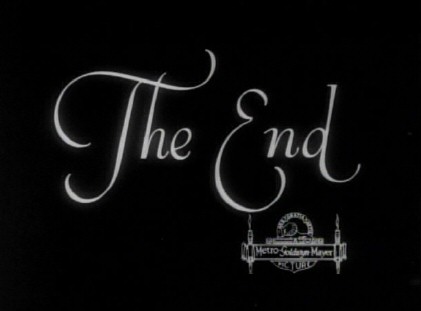
The Best of Everything
Encyclopedia Entry • Films Main
Possessed
1931

Critics' Reviews • Our Reviews • Movie Posters • Lobby Cards • Misc. Images
Click here to see photos from the film.
US release: 11/21/31. VHS release: 12/5/90. Warner Archive DVD release: 3/23/09. Cast: Joan Crawford (as "Marian Martin" aka "Mrs. Moreland"), Clark Gable, Wallace Ford, Skeets Gallagher, Frank Conroy, Marjorie White, John Miljan, Clara Blandick. Credits: From the play "The Mirage" by Edgar Selwyn (which opened in New York 9/30/20). Adaptation: Lenore Coffee. Director: Clarence Brown. Producers: Clarence Brown, Harry Rapf, Irving Thalberg (last two uncredited). Camera: Oliver T. Marsh. Editor: William LeVanway. Art Direction: Cedric Gibbons. Costume Design: Adrian. Sound: Douglas Shearer.
Plot Summary: Joan Crawford is her usual upwardly mobile self in this melodrama co-starring Clark Gable. She plays Marian Martin, a cynical small-town girl determining to give up the idea of marriage. Kept by wealthy attorney Mark Whitney (Gable), Marian assumes a new identity as a divorced woman of the world, but her newfound life of luxury comes crashing down when Mark decides to run in the gubernatorial race. A rival leaks her real identity and Marian is forced to defend herself at one of Mark's election rallies. Her story brings the crowd to tears, however, and a relieved Mark proposes marriage. Based on a 1920 play by Edgar Selwyn, Possessed had been filmed previously in 1924 as The Mirage, a vehicle for silent star Florence Vidor. ~ Hans J. Wollstein, All Movie Guide
Notes: • This was Joan's 3rd of 8 films with Clark Gable. The two began an affair while filming, which would continue off and on until his death in 1960. • The film was shot in 26 days, beginning 9/21/31. • It cost $378,000 and made a profit of $611,000. (Mayer and Thalberg, by Samuel Marx) • Possessed ran into trouble with British censors because of the unwed status of the main characters. To placate the censors, MGM production chief Irving Thalberg had some scenes reworked for the UK audience: In this alternate version, Gable is married to an invalid (unlike the US version, where his wife has run off with his chauffeur) and he remains physically loyal to her while platonically in love with Joan until the wife later dies. (Ultimate Star) • The film was released in France with the title Fascination. (JCB)
|
|
Mordaunt Hall in the New York Times November 28,1931
Through Clarence Brown's able direction, handsome settings and a fairly well-written script, "Possessed," the new picture at the Capitol, is a gratifying entertainment. It is an adaptation of Edgar Selwyn's play "Mirage," which was presented here eleven years ago. The familiar theme or a small-town factory girl who becomes the mistress of a wealthy New Yorker is set forth with new ideas which result in surprises if not in a measure of suspense.
Joan Crawford impersonates Marian, an ingenuous and trusting toiler in a paper-box factory. It is presumed that she is mildly interested in a co-worker named Al Manning, played by Wallace Ford. A train with a special car which stops at her home heath and a talk with one of the passengers, Wally, who gives her his card, causes Marian to go to New York. She has no illusions about remaining good. Her idea is to find a rich man, and although her first talk in the metropolis with Wally is discouraging she is persistent and thus meets Mark Whitney, a lawyer of some consequence, whose marriage has turned out a dismal failure.
Whitney supplies Marian with the luxuries of life and in three years she becomes a woman of the world, one who can speak a little French, knows the wines for the different dinner courses and their necessary temperatures, has a pleasant singing voice and reveals a sense of humor. She really loves Whitney, and his only reason for not marrying her is that he dreads the resurrecting of the scandal connected with his divorce. To avoid suspicion of their relations so far as it is possible, Whitney prevails upon Marian to pose as a divorcée and take the name of Mrs. Moreland.
The young sweetheart of the small town then comes to see her, believing that she is a divorcée. He wishes to make her his wife, but although he has been moderately successful and is eager to obtain Whitney's support on a road construction contract, he is the same more or less uncouth individual he was when he worked in the box factory.
Manning's crudeness is adroitly contrasted with Whitney's savoir faire, so much so that one's sympathy, notwithstanding what has happened, is for Whitney. The lawyer, however, is led to believe that Marian is desirous of abandoning her relations with him and of becoming Manning's wife. Marian, herself, insists to Whitney that she favors marriage to Manning, but she does so because she feels that she is handicapping the lawyer's chances to be nominated for Governor.
There is a contretemps in the latter stages of the proceedings, as Whitney believes Marian. Manning, however, reveals himself to be governed by mercenary motives, particularly after Marian informs him that she has not been married and has been living as Whitney's mistress. He is eventually dismissed by Marian and there follows a most effective climax, when rival politicians attack Mark Whitney's private life.
There are many interesting minor details put into the sequences and the final episodes are pictured in a stirring fashion. Miss Crawford adds another excellent performance to her list and Mr. Gable delivers a portrayal that is nicely restrained. Skeets Gallagher handles his lines in his usual competent manner and Mr. Ford rises to what is demanded of him.
James R. Quirk in Photoplay (1931): ...Lots of luxury; lots of charm; lots of smooth talk about courage and marriage and what women want--that's Possessed, and you really don't care if the story is old and some of the lines a little shopworn....It's the best work Joan Crawford has done since Paid, and Clark Gable--he's everybody's big moment. If Joan weren't so good, he'd have the picture.
Paul Mavis for DVDtalk.com (2010): The first half of Possessed lays it right out there: if you're a poor but beautiful woman in the Great Depression, you can join the "in" crowd quite easily...by giving your body to a rich man. And if you're a rich, influential man, you can acquire and train a mistress, without the emotional strings of a wife, by simply paying for one. But Lenore Coffee's hard-nosed, unsentimental first half gives way to a thoroughly conventional "pain and suffering" melodrama, a thematically dishonest amelioration that smacks of obvious audience calculation. Still, that first half is a stunner, with a weird pull to it, and Crawford and Gable make a hot duo. I'm recommending Possessed. Full review with screen shots. |
If you've seen Possessed '31 and would like to share your review here, please e-mail me. Include a picture of yourself or avatar to accompany your review, as well as a star-rating (with 5 stars the best) and any of your favorite lines from the film.
|
Rating:
Possessed
(1931) has a lot going for it. Great cinematography, lots of good
scenes, good dialogue, Joan's amazing looks, and a lead character you can
get invested in.
Possessed may have more good scenes than any Joan film of the era I can think of: The “other side of the tracks” scene, the scene with Marjorie White, Joan singing in 3 languages, the torrid “fur drops to the floor” scene, etc. Kudos to director Clarence Brown. Even scenes like the one where Clark slaps Joan are good, albeit hard to watch. (I always hit pause here to prepare myself for this emotional scene. My discomfort was eased when I watched a 1960s interview: JC said Clark caught more of her face than intended. Joan said his hand was trembling, and he couldn’t wait for them to call “Cut” so he could hold her and apologize.) A small vignette I like occurs early in Possessed:
Joan/Marian and her beau Al (Wallace Ford) are arguing over why she
won't marry him. As they do so, there is a couple in a ramshackle house
in the background performing a pantomime. The man is drunk and his wife
beside herself dealing with the besotted loser, while he seems hell-bent
on further debauchery. It's a little thing, but I feel that is giving a
preview of Marian's future if she doesn't get outta town. Possessed
has a feminist theme. For example, when Marian is arguing with her mom
and Al about wanting to break free from her dead-end job/town, she
says:
“If I were a man it wouldn't frighten you! You'd think it was right for me to go out and get anything I could out of life, and use anything I had to get it.” One can envisage many women enduring the financial and societal strictures of the Great Depression and muttering a collective "You Go Girl!” under their breath. Marian is unashamed in her desire to snag a rich man and get the life she wants. But it doesn't seem malicious or conniving a la Barbara Stanwyck in Baby Face. Happily, for Joan, her rich meal ticket away from Dreary Erie is Clark Gable, a lawyer with political aspirations. He gives Marian the life she dreamt of, and he is a decent guy who truly loves her. And she loves him. Is Possessed a great film? It's close, near great. I think the corny ending dilutes things a bit, especially as this is pre-code and presumably Brown had wiggle room to forego the trite "they lived happily ever after" ending. But, to be fair, the public likely wanted a Crawford-Gable hookup ending. And, MGM gave it to them. Another thing that prevents a "great" classification in my mind is that the supporting cast is OK, but not as good as other Joan MGM flicks. There's really not much for them to do; this picture is all about Joan’s character. Even BM (before mustache) Gable is a tad stiff at times, having not yet fully harnessed the charisma that would make him The King for 3 decades. Skeets Gallagher stands out among the supporting cast. He was an accomplished second banana in films like the early Carole Lombard vehicle It Pays to Advertise and the Kay Francis rom-com Let's Go Native. Wallace Ford is Al, Joan's hometown lover, who resurfaces at the end to be Gable's rival for Joan (Good luck with that!). He's OK, but any of a dozen character actors could have played the part. Possessed
is all Joan, a vision of feminine pulchritude: She sings well, plays a
woman who knows what she wants, and she gets to burn up the screen with
Clark Gable. All this packed into 76 minutes. What's not to love?
Rating:
Possessed---based on a 1920 Broadway play, The Mirage---is an emotionally honest, and sometimes emotionally ugly, film, despite its accoutrements of Joan and Clark Gable looking quite beautifully sexy together. Both Crawford and Gable are just now starting to solidify their onscreen personas that would define them for decades to come: both innately "honest" and "good eggs" despite their beauty and troubled circumstances that might lead them astray (though Joan was often led quite a bit more "astray" in years to come, thanks to the vagaries of Hollywood that took her from heroine to harridan, while Gable stayed predictably noble).
Contrary to Joan's earlier films from 1925 until this point, which usually featured Joan either winding up with the good-hearted working-class guy or the good-hearted rich guy, Possessed has two complicated characters in Joan's "Marian" and Gable's "Mark Whitney." Marian is clearly fed up with everything about her working-class life in the paper box factory. She can't explain properly what she wants ("I dunno. I only know I won't find it here."), and she's mean to her decent boyfriend Al (Wallace Ford), whom she calls a "turnip" for no real reason. She glimpses the good life via passing train cars at her town's crossroads (a very clever, now-famous shot with various scenarios as she stands there gazing in the windows while the train passes by: servants mixing drinks, laying out fancy tableware, ironing fancy underclothes; followed by a glamorous woman putting on the underclothes, then a long 3-car shot of the woman and her beau dancing together in evening clothes and kissing).
At the tail-end of the train cars, Marian finds the louche "Wally" (Skeets Gallagher), who drunkenly espouses philosophy ("Only 2 kinds of people: the ones in and the ones out" and, later "The East River is full of girls who took advice from men like me") and invites her to visit him in New York City...
Gallagher's "Wally" serves as a kind of Greek chorus in the film. He speaks the truth about how how weak he himself is, and about what Marian's chances are in the "big city," and how she must rely on both her looks and on finding a rich man (though he won't introduce her to his friends). Once she's admitted she's there in the city not for cliched reasons (like caring for a sick mother or something) but rather "for me," he deigns to examine her under not daylight but a lamp ("That's the kind of light you'll be working under"): Lovely eyes, intelligent forehead (not so good!), straight nose with plenty of spirit (show it!), warm mouth with plenty of pride (hide it!).
As Wally ushers her out, she runs into Gable's "Mark Whitney" by the elevator. Taking literally what she's just learned from Wally, Marian turns around and follows Mark back into Wally's apartment. Whitney is charmed by her obvious lack of wiles and sincere literal hunger... Cut to him taking her to a restaurant where she can't read the French menu. And then clever film editing as a bejeweled arm tears down pages from 1928, 1929, 1930, and 1931 from a calendar---with each year, the arm gains another diamond bracelet. And then cut again to Marian at Whitney's apartment instructing servants in French about the menu and wine selections.
Marian is now established as Mark's mistress. In another now-famous pre-Code scene, Gable picks her up at her apartment at 7:45pm for the 8:00pm dinner party at his apartment (the clock shows the exact time). As they continually caress, he hands her pieces of jewelry and they reminisce about the cities they've visited when he bought her each piece. At the end of the sequence, they embrace and her fur drops to the floor... Cut to a clock showing 9:30pm as they arrive quite late for Mark's own party!
At the party is another iconic scene: A business-friend of Mark's arrives with an obvious floozy (Marjorie White) and compares her to Marian. What makes Marian different from this woman? And then, what makes Marian different from her old turnip-beau Al when he shows up the next day as a much-richer man who has, like Marian, made something of himself and is now determined to win Marian back?
In a less psychologically sophisticated film from just a year or two back, Joan's Marian might have ended up with the good-natured turnip Al, both grateful to be done with the machinations of the Big City: "We talk a lot of nonsense here in New York," says Marian. This film, though, is much more emotionally complicated and interesting. It's not so much the money and outer trappings that matter, but rather, how you feel INSIDE. Marian and old-beau Al might have both now made money in nefarious ways, but she's still not LIKE him internally. (And when she politely turns Al's marriage proposal down after a day of literally grabbing for the gold ring on Coney Island carousels, Al reveals his own whoredom after denouncing Marian's relationship with Whitney: He needs Whitney for a highway deal, so wants Marian to put in a good word for him...)
Gable's character Whitney is bold and sexy and a straight-shooter, but still a man protecting himself and capable of cruelty: For instance, when Whitney apologizes for his friend's behavior at the party, Marian replies: "A woman can do anything, get anywhere. As long as she doesn't fall in love." She also points out that "Those things don't happen to wives." Whitney, instead of understanding, makes comments about pigeons they'd once fed in Venice---which had kept coming back because they weren't chained... Later, when meeting with Al at his office, Whitney makes a comment that "Sometimes one becomes attached to investments" while looking at his $3300 monthly bill for Marian's apartment.
It's a tangled web, these emotional and financial and societal ties! Possessed makes it clear that Marian and Mark Whitney love each other, yet there is still plenty to suggest otherwise, and plenty to suggest that Whitney's burgeoning political career might be in danger (thought that isn't the point of the film). There's a lot going on here, and just about all of it seems to ring true. Kudos to Joan and Gable for their acting honesty, and to their director Brown for pulling all their complications together, including in the final moving scene and its satisfying rain-drenched conclusion!
This film happens to be my
50th "Best of Everything" website review for Miss Joan Crawford,
Movie Star. It's perfect for me that this is my 50th review because Possessed is one of my,
as well as Joan's, favorites. By a chance meeting with a wealthy
train passenger as she looks hungrily in at his seemingly elegant, unreachable
world, Marian finds a way out of her small-town drudgery and gets to the big
city to stake her claim. Of course, she hits a home run meeting Clark Gable in
his prime! Lucky for her, he is a dream man, brutally honest yet sensitive.
And Joan is all woman. Just enjoy how the love between these two highly
attractive people plays out. The character actors are some of the
best, giving their minor parts "character and depth and class," as
Joan later said. Clara Blandick is her mom (later to become immortal as "Auntie
Em" in "The Wizard of Oz"); I just wish she had showed up later in
the picture wearing a diamond bracelet and fur from Fifth Avenue! And I've loved Wallace Ford ever since seeing this movie--all
of the B movies he did after this up to his final real character portrait in 1965's
A Patch of Blue. Skeets Gallagher
was perfect as the rich man who drinks a lot, his proffered glasses of
champagne initially inspiring Marian to run from her turnip-loving boyfriend. Frank
Conroy (Grand Hotel, 1932), John
Miljan (Paid, 1930), and the talented Marjorie White (sadly dead at 31 in a car
wreck) also all helped to make this film and Miss Crawford tops at the box
office during this time.
On a final note: Hedda Hopper once
said about Joan, "If she doesn't make another 50 movies, it won't be her
fault." I wish I could write 50 more reviews and, like Joan and her thoughts
about most of her films, I wish I could re-do them all! Miss Crawford and her
films have opened the door for me to many wonderful actors and hundreds of
other films. I have also learned about the technical crews, the
dozens of writers and directors, and old Hollywood studios and our American
film history. Thank you, Joan, for letting me get to know you and your body of
work.
Patrick (September 2007)
Rating:
"On the edge of a precipice" --- Possessed.
[Warning: Spoilers!]
This movie is in some ways a summation of Joan Crawford's MGM career and a good example of the lush fantasy the era it was produced in called for - and just what MGM and only MGM could deliver. It was 1931 and the Great Depression was devastating lives across America and the world. The movies gave America escapist fantasy, and the stars were like gods and goddesses from another world. Yet oftentimes movies had touches that the everyday Man and Woman of the 1930s could relate to - and aspire to. This film and its stars fulfill that dream perfectly. The film opens with Crawford leaving a factory amidst all her coworkers, streaming out after a long day's work and greeting her is her beau. They walk a ways together, slowly amidst a backdrop of the working class - dirt streets, simple homes, children playing in simple clothes, while the beau speak to her about marriage and his aspirations. She doesn't want to marry him....but she will see him later, and walks ahead alone.
As she approaches the railroad tracks (the famous "wrong side of the tracks" metaphor) a train is going through town and slows down. What happens next could only happen in the dreamland that was Metro-Goldwyn-Mayer. As the train slows to a crawl, Crawford stops to watch. Inside each compartment are beautiful things, things audiences in 1931 could only imagine - cooks preparing amazing meals; a butler setting an elegant table; a maid ironing lingerie; a lady in her lingerie putting on her stockings and next to her the shadow of a man shaving; in the next compartment Crawford watches as a couple dance slowly across their elegant compartment and it culminates in a sweeping kiss; and finally the train stops and standing at the caboose is a rather hammered man who starts speaking to Joan. Joan befriends him, she takes his card, then returns to her shack across the tracks to her hardworking mother and beau who screams at her for letting the ice cream melt and rips up the card the man she has met has given her. He storms out; she tapes the card back together and leaves for New York to see the man.
She arrives in New York and meets the man - he doesn't remember her but audiences are treated to an interesting segment where she describes her ambition in life. This is where we have a moment only found in an early-30s Crawford film. Before she leaves, the man sits her down and shines a lamp in her face and we all get to see - the first of many beautiful instances in the film - the amazing Crawford Face. He moves her face so it is straight-on, and then moves her face into profile and again the other direction so this amazing face with its amazing planes and angles can be seen in all its glory. A beautiful moment, and once again something from another world. The man tells Crawford to do what she can and take a chance when she sees something good.
After Crawford leaves, she is standing by the elevator when Clark Gable and another man get out and walk into the apartment she has just left without noticing Crawford. Intrigued by Gable's handsomeness and emboldened by the man's words, she walks back into the apartment under the pretense of having left her hat, but not before a quick exchange with the elevator conductor - he asks her if she's going down - she says no, she is not - a metaphor for the fact she is going up in life and not back down to the street and her crummy life, boyfriend and job.
Here we meet Clark Gable, a very young Gable with no lines on his face or his famous little moustache. He does however already have the Clark Gable smugness - and his character of course quickly sees through her hat ruse. Crawford says she is looking to meet a rich man - and when Gable's colleague says he is already married she turns to Gable, who starts this rather infuriating speech detailing his already existing wealth - you see he is "What's known as a very rich man". Crawford is turned on and they strike a deal and leave the apartment together. In the next scene audiences get another taste of the Proletariat side of Crawford audiences related to. Gable takes her to a fancy French restaurant but she orders roast beef, mashed potatoes, string beans and an apple pie with ice cream - a meal of the People. Though the waiter is horrified, Gable orders the same - for Gable is a Proletariat Star as well. Fade Out.
Fade In, Crawford is ordering food off a French menu in her gracious home with Gable, and wearing a gorgeous Adrian gown. Listen carefully - for in French, the new, classy Crawford is ordering just what she ordered in English in the previous scene. For lo, though she may have millions she still enjoys mashed potatoes and roast beef. She subsequently begins dictating to her French butler directions for an upcoming party while deciding where to put the place cards on the table. Champagne exactly room temperature and so forth - how many women sitting in the audience for this film melted at a scene like this? However in the next room is Gable, speaking to the same man Crawford initially met - he asks Gable why he won't marry her. Gable cannot marry her. She is not his class and what's more, he is running for Governor of the state and can't be seen with a...woman like that. Fade out.
Fade in, Crawford is dressing in front of a mirror for a party, looking so beautiful it hurts. Hair perfectly marcelled, huge jewels dripping off her ears, a gorgeous Adrian gown hanging off her shoulders, MGM lighting men turning her face into a Greek sculpture. Gable comes up behind her and starts draping necklaces around her and putting rings on her fingers and the audience is told exactly when and where he gave her these jewels. Finally he hands her a ring and it's Crawford who says that he bought it at Tiffany's, when they decided she would be called "Mrs. Moreland." Gable won't marry her but will build a fake life for her so their spending time together is "acceptable." The shame on her face is wrenching but the shame is beautiful.
Fade in the party, an old friend of Gable's arrives with a woman (delightfully played by Marjorie White) who is definitely not his wife, but a cheap blonde girl who is being taken for a ride by this rich man. Gable is appalled he would bring that "tramp" to the party but in front of the girl and Crawford the man asks why it's ok for Gable to bring Crawford but he can't bring the girl? What is the difference? Crawford is humiliated and Gable outraged, but Crawford knows the truth. For all her jewels and gowns she is no better than the girl. She realizes she has sold her soul for a life of luxury. Once again, she is shamed. Retreating to an anteroom, she is consoled by Gable. They turn to embrace, the keylights crank up and we are treated to a gorgeous shot of Crawford in agony, speaking of her torment, her love for Gable, telling of how she feels as if she were "standing on the edge of a precipice". Her face is beautiful, her torment is real, for she is not her own woman any longer, she is no longer free, she is "Mrs. Moreland", she is Possessed.
How many women were sitting in those darkened movie palaces in 1931, gripping their armrests, being tormented along with Crawford, wishing that they could be in her place? How hard and often did they wish they could be taken out of their dreary lives, away from the Great Depression, the breadlines, the fear of losing everything, the day-to-day scraping by, and be whisked away to this Otherworldly Oz Crawford lived in and be in her place? To love a man like Gable, to be beautiful like Crawford, to be owned, but be owned LIKE THAT?
Later, Gable arrives home with some political advisors and Crawford hides in the next room. Gable's advisors tell him Mrs. Moreland must go away - what will the voters think if their Great Hope is having an affair with a married woman? Crawford watches from the next room, terrified her presence will ruin the career of the man she loves. What must she do? This beautifully shot as the shadows cascade at an angle across Crawford's face only revealing her one huge, staring eye as the rest of her face is hidden in shadow. A gorgeous metaphor for her presence in Gable's life. Crawford must make a sacrifice - not just give up la dolce vita but the man she loves. She pretends to renounce him and an infuriated Gable tells her to get out. Fade out.
Fade in; it's the night of the big rally Gable is doing to try to win his election as Governor. Thousands stream in to hear him speak and Crawford comes in as well, wearing a coat and a large hat to hide her face. She has made the ultimate sacrifice for him and has come to show her support anonymously amidst all Gable's other supporters. Gable's winning over the audience with his brilliant answers to the audience's questions when pieces of paper start coming down from the roof of the building. Gable and Crawford both pick them up and the paper reads "Who is Mrs. Moreland?". Gable's political enemies have done this stunt to destroy him. The audience starts screaming, wanting to know who Mrs. Moreland is. ... [Editor's note: At this point, I must delete a huge spoiler segment of Patrick's text!]
Certainly an extraordinary ending to an extraordinary movie. At times somewhat infuriating - exactly how is this all supposed to really happen?? - But visually beautiful and beautifully acted. Only MGM could give us a film this wondrous and only Crawford could play the noble woman at its center.
Michael H. (January 2005)
Possessed IS Joan Crawford!
Get this: When the picture starts, the whistle is blowing quitting time and all these employees stream out, Joan included -- where does she work? In a box factory. Not in a factory that makes things that GO in boxes, just the empty boxes themselves.
It gets better. To get home, Joan has to CROSS THE RAILROAD TRACKS. Yes, Joan lives on the WRONG side of the tracks. And then she can't even get across the tracks because here comes a train. As Joan waits for the train to cross she can see inside each compartment, and inside every window is a representation of what her life is NOT. Fine silken lingerie being put away. A man and woman in full evening dress dance in their compartment. A couple toast each other over a romantic dinner. As Joan salivates over all this largesse and the caboose passes, for reasons never explained, the train completely stops. Keep in mind, Joan is not at the station. She's standing right next to the tracks, in the dirt. Not on a platform.
And on this caboose is -- with all due respect -- a drunk fairy. There's really no other way to describe him, and I'm certain that's exactly what he was meant to be. Dandified, fey, and of course, drunk. But rich. Of course, being a rich drunk fairy he's not happy either, and it amuses him to tease small-town Joan with all the fancies in life she so desires and can't have. To really rub it in, he gives her his card and says if she's ever in town to come see him.
...She shows up unannounced at the drunk fairy's fancy Fifth Avenue penthouse apartment, but he's not drunk now. Now he's hungover. (I swear it. Wait 'till you see how MGM presents him -- I'm not exaggerating. It really is insulting.) Anyway, he comes out hungover, doesn't remember her, but recognizes her for a hick. After spouting some high-flown dialogue the scriptwriters gave him to demonstrate his true sophistication, he sits Joan down, shines a reading lamp in her face, and we all get a good long look at that incredible Crawford face. Then he shows her the door, and she doesn't even realize she's outside the penthouse until she turns around and sees the door in her face.
Dejected, she waits for the elevator and when it opens, out steps Clark Gable with some of his cronies. Joan recognizes them from the "Society" pages and follows them back in like an eager puppy. Well of course Gable is amused by her raw spunkiness and in the next scene there's Joan circling a formal dining table wearing one of Adrian's best gowns, giving orders in French to a butler and instructions about keeping the champagne properly chilled. Not a cardboard box in sight.
One of the guests arrives bringing his latest 'friend', some poor slob of a girl who's getting the make put on her by this rich creep. Gable is insulted his guest would bring her, Joan is regally sympathetic, and now the point of the picture is clear: No matter how many Adrian gowns she wears, no matter how well she fools everybody with her perfect French, Joan is really a kept woman from the wrong side of the tracks that no man will ever marry. The heartbreak written on her brow is CLASSIC.
Later in the movie, Joan is dressing for a party and Gable comes in and says, Ready? Joan hesitates, then straightens her shoulders, along with her resolve, and drapes a simple diamond necklace around her neck. Gable comes up behind her and says, remember when I gave you this? Joan nods dreamily. Then he picks up a large diamond brooch and says, Remember when I gave you this? Joan's face scrunches up in shameful ecstasy and she nods again. And this? he asks again, and he picks up this goddamn necklace with diamonds the size of ice cubes and puts it around her wrist. Joan flings hers around him and holds him desperately, looking into her keylights with perfect aim. She is thisfaraway from being crucified by her love for Gable, who will never marry her, who she will never marry, because she used to work in a box factory, and now she's a kept woman.
How beautiful MGM makes the shame. And you know every woman sitting in a theater in 1931 wished they could suffer like that. They ACHED to suffer like that. And at the end of the picture, those women went home and turned out the lights and crawled into bed, and wondered how they would get through another day of the Great Depression. If only they looked like Joan Crawford. Yes, they'd be living in shame, but it would be SO WORTH IT.
The scene ends with Joan and Gable showing up late to another party, Joan's dress all wrinkled and Gable's tie askew, and everybody knows why they were late.
To cover her shameful existence and continue consorting with Gable, Joan begins calling herself "Mrs. Moreland" -- divorced or widowed I'm not sure, but what's important is that she's no longer a married woman, BUT HAD BEEN!
Gable is encouraged to run for political office BUT -- what about the Mrs. Moreland problem? What if his opponent chose to publicize Gable's relationship with Mrs. Moreland? What happened to Mrs. Moreland's husband, anyway? Joan is hiding on the balcony when she overhears the cronies discussing her, and her fist goes to her mouth! Her love for Gable is going to cost him a wonderful political future, and deprive Americans of the man they need to lead them out of the dark days of the Depression. Her only option is to leave him. And the light hits her so brightly at the thought that you think she just might begin Ascending, so noble is her sacrifice.
Joan concocts some silly argument (probably in French, it made so little sense to me) but Gable, thinking she's finally revealing herself as the cheap box-girl she really is, dumps her and runs for office after all, the Mrs. Moreland problem solved to his cronies' satisfaction.
Cut to the big public rally. Huge posters of Gable hang all over Madison Square Garden, and there's Joan, slinking into the auditorium alone, offering her undying support, though Gable will never know it. Just as Gable begins winning the crowd over with his pithy answers to their probing questions, confetti starts floating down on the crowd. Joan picks up one of the shreds and on the paper is written "What about Mrs. Moreland?" The whole crowd starts muttering and getting louder and getting more insistent, and Gable begins to grow concerned, and just as the crowd is reaching fever pitch, little 5' 4" Joan stands up and ... [Here's where I, the mean editor, have to delete a whole paragraph out of Mike's narrative to avoid the ultimate spoiler!]
And you know what happens... I have a feeling her hair probably got pretty messed up that night.
THE END.
You know, the picture really is a nutty, schizophrenic mess, but what I remember most about it is how great Crawford looked. The movie is not nearly as visual as the Dietrich-von Sternberg ego massages, but when everything is said and done, all I remember is how incredible Crawford looked.
I love it. |
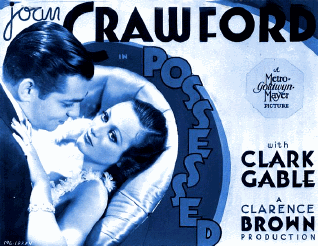
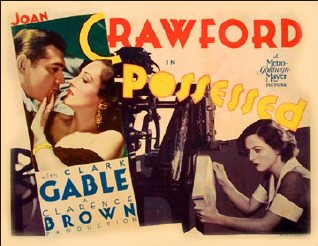
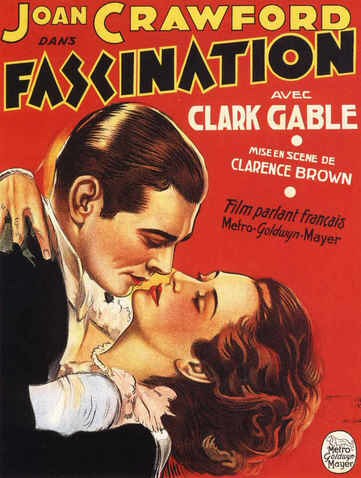
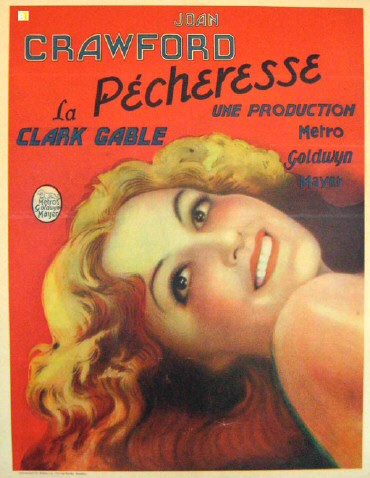
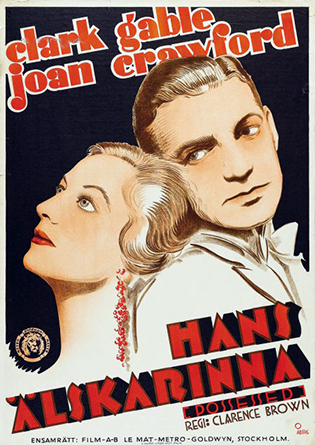
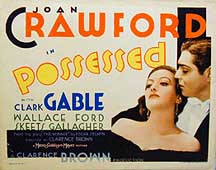

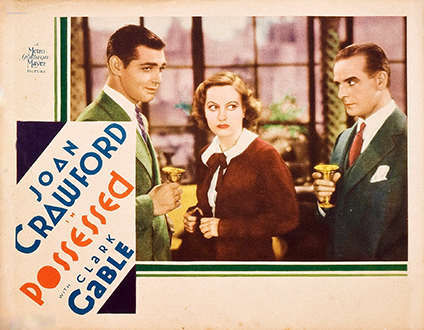


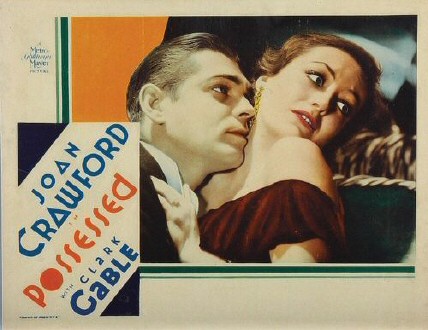
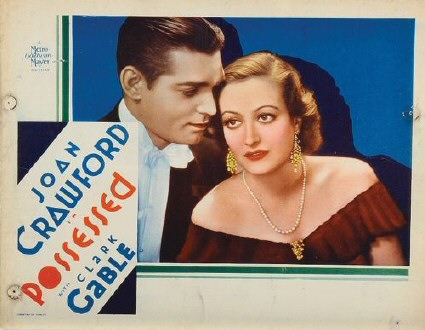

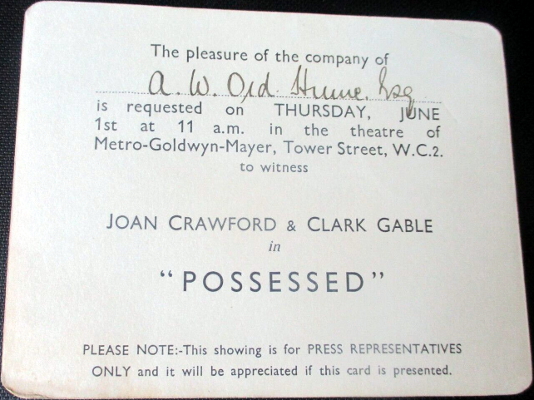
Above left: Joan's copy of the script. Above right: UK press pass to London showing.
Below: Baltimore, Maryland, program featuring Possessed.
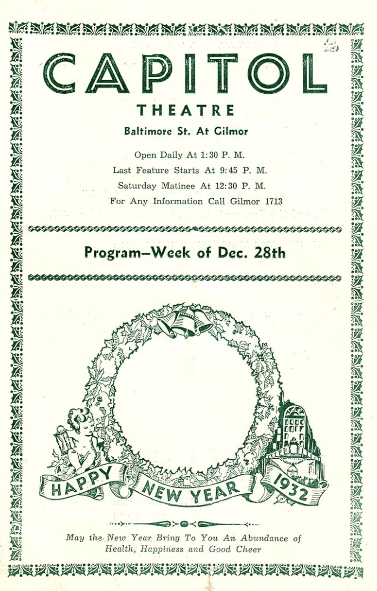

Below: US glass slide, US herald, US sheet music.

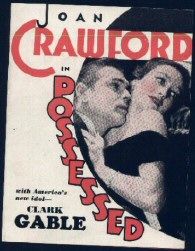
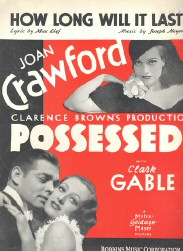
Below: Newspaper ads from the New York Times and unknown.
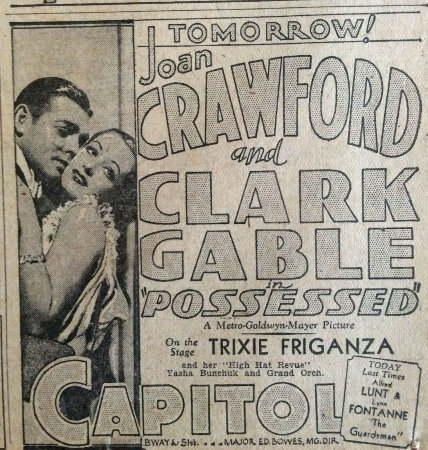
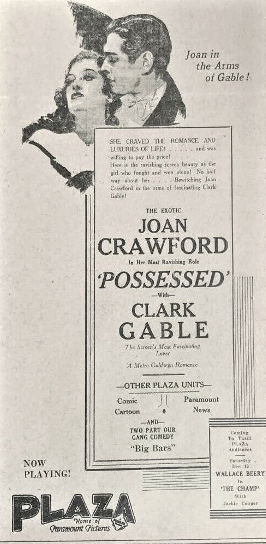
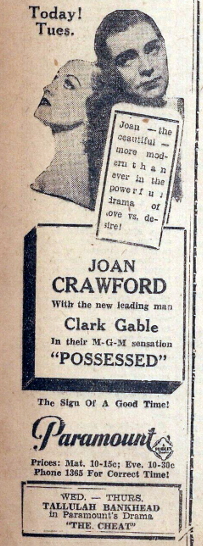
Below: Three newspaper ads from Oakland, CA.


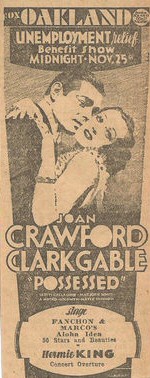
The Best of Everything
